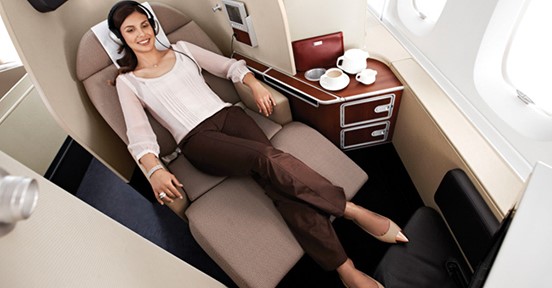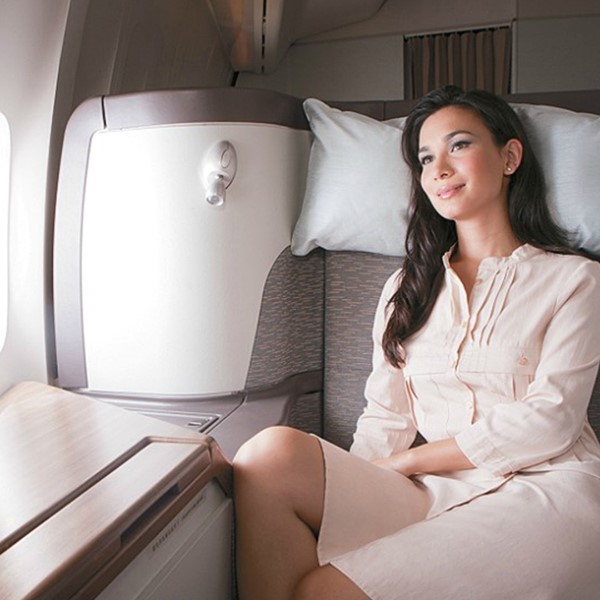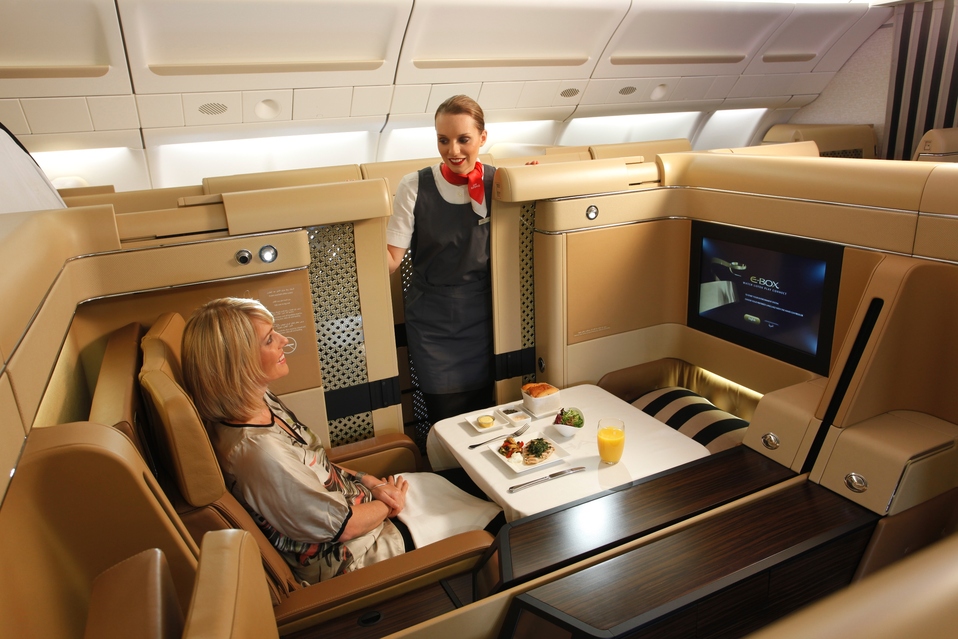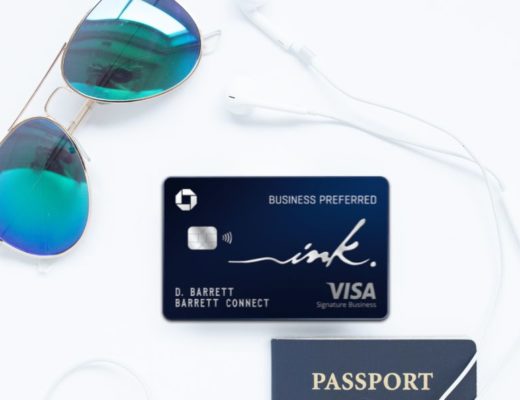First step on your way to free luxury travel is to understand basics of how Airline Rewards Programs work, so you can choose best one for you. Frequent flyer programs provide extra perks to those who travel regularly, but even infrequent traveler can use miles for luxury flights to exciting destinations.

If you travel by plane at all, you’ve probably thought about getting a frequent flyer card so you can earn miles for free travel. Or, you may already have an assortment of frequent flyer cards riding around in your wallet. Today’s frequent flyer (FF) programs offer benefits above and beyond free air travel. And, you can earn miles without even traveling anywhere.
In the following series I will review major Airline Rewards Programs: United, Delta, American, Southwest and I will look at British Airways Avios as well. So keep reading!
If you are new to earning Frequent Flyer Program, do not get overwhelmed by number of details and ways to earn miles. It’s not that hard. Start with signing up for free Frequent Flyer Program membership with your airline you fly, and then use this series of articles to slowly get comfortable with earning miles. Remember, I am doing this for almost 20 years and I learn something new all the time. Hope you found this article helpful, and if you did spread the word about > !!!!! PointsTravels.com !!!!!
 The frequent flyer program is an incentive program operated by an airline to reward customers for their continued loyalty. As a traveler, you earn free miles for the miles that you fly on a particular airline. The concept behind frequent flyer programs is that the airlines want their passengers to become lifetime customers. It is much more costly for the airlines to get new customers than it is to retain the ones they already have. So how do they reward you? The more frequently you fly with them, the greater your awards.
The frequent flyer program is an incentive program operated by an airline to reward customers for their continued loyalty. As a traveler, you earn free miles for the miles that you fly on a particular airline. The concept behind frequent flyer programs is that the airlines want their passengers to become lifetime customers. It is much more costly for the airlines to get new customers than it is to retain the ones they already have. So how do they reward you? The more frequently you fly with them, the greater your awards.
How it started
It all started in 1981, when American Airlines introduced a program called AAdvantage. Their purpose was simple: to reward customers for using the airline and promote future customer loyalty. American started the program by using their customer database. They tracked the members’ number of flown miles and put together a reward system of “a mile earned for a mile traveled.” To round out the array of services for the travel customer, American also included Hertz rental cars and Hyatt hotel stays in the program. It was an instant success. United Airlines almost immediately debuted their Mileage Plusprogram and upped the ante by offering an “enrollment bonus” of 5,000 miles! As expected, the other major domestic airlines soon followed suit.
 Next, the hotel industry entered the game. Initially, they merely participated as “partners” in the airline programs. However, considering their costs as an airline partner, most hotel chains initiated their own frequent-stay programs. Today, although most hotels do have their own frequent-stay programs, they remain partners with all the major airlines because it leads to increased sales.
Next, the hotel industry entered the game. Initially, they merely participated as “partners” in the airline programs. However, considering their costs as an airline partner, most hotel chains initiated their own frequent-stay programs. Today, although most hotels do have their own frequent-stay programs, they remain partners with all the major airlines because it leads to increased sales.
The rental car industry initially participated by becoming a partner with the airlines. As the costs of the relationships with the airlines rose, Hertz, the early leader, withdrew from the FF relationship. However, when their market share dropped drastically, they rejoined. Hertz now collaborates in more than 60 FF programs (domestic and international partners combined).
In today’s market in addition to the many airline partner programs, there are several airline alliances (more about these alliances a little later).
 Another perk in today’s frequent flyer market is that you can also earn “miles” or “points” (points can be redeemed later as miles) for other travel and non-travel transactions.
Another perk in today’s frequent flyer market is that you can also earn “miles” or “points” (points can be redeemed later as miles) for other travel and non-travel transactions.
Travel transactions can include hotel stays, rental cars, and more. Non-travel-related awards include credit card purchases (you earn at least one mile, if not more for every dollar charged), long-distance telephone services, even mortgages and stock trades!
Finally, shopping at certain stores, both brick-and-mortar and online, also provides an opportunity to “rack up” those miles.
Your frequent flyer miles reside in your account — much like your dollars in the bank. They accumulate as you travel, although unfortunately they don’t earn interest. At this time, most of the larger domestic airlines use a fairly uniform policy: mileage does not expire, but there must be some activity in your account once every 18 mos. to three years. The airlines may change their mileage expiration policies, so you should read their most current guidelines. When the mileage total reaches a certain amount, you can “redeem” them for an award, usually air travel.
Choosing a Frequent Flyer Program
In the following series I will review major Airline Rewards Programs: United, Delta, American, Southwest and I will look at British Airways Avios as well.
 Frequent flyer programs are the beginning of a relationship — hopefully long and loyal — between you (the consumer) and the airline. If you choose to apply online using a Web site such as WebFlyer, your information will reside in several airline databases in a short amount of time. You can call the airlines on their toll-free telephone numbers (during which you’ll instantly get a member number), sign up while at the airport (not advisable if you are in a rush), or send in the registration form using the old standby — U.S. mail.
Frequent flyer programs are the beginning of a relationship — hopefully long and loyal — between you (the consumer) and the airline. If you choose to apply online using a Web site such as WebFlyer, your information will reside in several airline databases in a short amount of time. You can call the airlines on their toll-free telephone numbers (during which you’ll instantly get a member number), sign up while at the airport (not advisable if you are in a rush), or send in the registration form using the old standby — U.S. mail.
There are several things to consider when deciding which frequent flyer program to join.
First and foremost, look at the overall quality ratings of the program that you are considering. One way to obtain information about the quality of frequent flyer programs is to read a survey, such as Inside Flyer’s Freddie Awards. This award system was named after Sir Freddie Laker, founder of Laker Airways.
If you truly are a frequent flyer, join the program that will allow you to consolidate your miles. This would usually be with the dominant airline in your region (i.e., they have a hub there). The chosen airline should be convenient for you and the one that has the most flights to the places that you frequent. This is your number one consideration, because when you rapidly accrue miles and reach the critical “25,000” mark, you can qualify for elite status.
However, if you are an infrequent flyer, compare the programs and choose the one that allows you the greatest opportunities to earn miles or points from all your non-flight activities. Consider your patterns of purchasing hotel rooms, renting cars, and general shopping.
Look at the airline’s partner roster and decide whether that particular frequent flyer program is for you.
 Many people place themselves in the middle of this overall group — they travel sometimes, and engage in non-flight activities awarding points/miles. If you are in this last group, you should compare the total rewards package offered for both flight and non-flight activities before choosing your primary frequent flyer program.
Many people place themselves in the middle of this overall group — they travel sometimes, and engage in non-flight activities awarding points/miles. If you are in this last group, you should compare the total rewards package offered for both flight and non-flight activities before choosing your primary frequent flyer program.
And, finally, you want to pay attention to the little things – the tiny print at the bottom or on the back of the enrollment form. Therein expect to find quite a few key terms and conditions, such as:
● It may be your membership, but it’s the airline’s program — hence, they own it. In addition, according to many airlines, miles and points do not represent property of the owner; in short, you don’t really own them.
● Every airline has some restrictions. These may include blackout dates and/or limited seating availability. The airlines plainly state that at any given time, you cannot count on any award being available.
● Airlines only count miles from origination to destination. If your plane stops along the way to your final destination, these are not recorded as segments. You’ll only receive mileage for the “point A to point B” distance. Also, airlines will not give mileage for voluntary changes in mid-flight — for example, if you voluntarily changed from a direct flight to a segmented one.
● If your flight is cancelled, you won’t be credited with the original flight’s miles. Airline policies regarding rebooking vary. When the original airline reeboks you, it won’t automatically credit the rebooked flight as miles to your account even if the cancellation is caused by the airline’s machinery (or any other technical problem on their end of the deal). For example, if your flight on United is cancelled and United reeboks you on Delta, United may not automatically award you Mileage plus miles for the Delta flight. However, for many airlines, awarding mileage to the customer’s account using the rebooked passage is situation-dependent, and may take into account how far you are willing to push for your miles.
● Most airlines offer “fee free” enrollment, but there will probably be an assortment of fees later. A fee may be charged for mileage redemption, accounts with no recent action, lost or stolen tickets, etc.
Airline Alliances
 When selecting a frequent flyer program, airline alliances are something else to consider. The ability to schedule seamless travel is important — airline alliances help make it possible. An alliance is a business relationship, often between U.S. domestic carriers and foreign ones. Its purpose is to allow foreign carriers access to the U.S. market and domestic carriers a means of access to “beyond-Europe” centers. The goal of alliance growth is twofold:
When selecting a frequent flyer program, airline alliances are something else to consider. The ability to schedule seamless travel is important — airline alliances help make it possible. An alliance is a business relationship, often between U.S. domestic carriers and foreign ones. Its purpose is to allow foreign carriers access to the U.S. market and domestic carriers a means of access to “beyond-Europe” centers. The goal of alliance growth is twofold:
● To offer global coverage
● To carry passengers around the world using ONLY their carriers
Examples include American Airlines allied with British Airways (One World), and United allied with Lufthansa.
Airlines code share so that travel can be organized to flow from one carrier to the other. Code sharing is the industry practice in which an airline puts its code on a flight operated by another carrier. The airline then sells and issues tickets for the flight. For example, American may place its code on a flight that British Airways operates and then sell it to the customer. This is how air carriers get around restrictions to expand their market presence. In today’s global economy, this truly benefits the frequent traveler.
When you travel using alliance carriers, the miles are credited and can be used interchangeably. This allows rapid accrual of miles so you can reach elite status quickly and receive the extra awards at that level.
Redeeming Frequent Flyer Miles
 Redeeming your miles is typically a straightforward process. You should always have your frequent flyer number handy when speaking with the airlines. You purchase a ticket with miles the same way you do with cash. They will use your number to access your account and subtract the appropriate amount of miles as you purchase the ticket. Tickets are available in paper form via regular mail or shipping carriers, and, of course, as an e-ticket. I use airlines websites to save on extra fees associated with by phone booking, but if you are first timer, call customer support.
Redeeming your miles is typically a straightforward process. You should always have your frequent flyer number handy when speaking with the airlines. You purchase a ticket with miles the same way you do with cash. They will use your number to access your account and subtract the appropriate amount of miles as you purchase the ticket. Tickets are available in paper form via regular mail or shipping carriers, and, of course, as an e-ticket. I use airlines websites to save on extra fees associated with by phone booking, but if you are first timer, call customer support.
But before you redeem, there are a few important issues that you should consider.
They could affect how and when you use your miles. There are quirks in the miles/points redemption process. The actual monetary value is typically 2 cents per frequent flyer mile (reportedly the airline industry average). For example, if you want to redeem 25,000 miles for a free ticket, the number of miles multiplied by 2 cents per mile is $500. As some industry researchers have noted, it may be smarter to save your miles and purchase a lower cost ticket to your destination.
Furthermore, the airlines have a notorious reputation for blackout dates and limited seat availability for frequent flyer customers using reward miles. One of the most important parts of your conversation with the ticket agent will be the answer to the question, “What’s available for the dates and flights that I want?” The airlines are under no obligation to offer any more than they decide is viable as outlined in their terms and conditions.
Finally, you don’t always have to use your miles for additional travel.
 You can use miles and points to purchase other goods and services with certain merchants. For example, registered users of Points.com can use extra miles and points to purchase gift certificates to hundreds of participating retailers. And don’t worry, the list isn’t a who’s who of obscure store names. You’ll find clothing retailers such as Banana Republic, Gap and Old Navy and department stores such as TJ Maxx, Target, Sears and JC Penney. And, for an even broader selection of goods, you’ll even find Amazon and eBay. Points.com users don’t only benefit from the variety of shopping possibilities, the free registration also includes some other useful services. In fact, the main feature is that you can create one central location for monitoring several award programs.
You can use miles and points to purchase other goods and services with certain merchants. For example, registered users of Points.com can use extra miles and points to purchase gift certificates to hundreds of participating retailers. And don’t worry, the list isn’t a who’s who of obscure store names. You’ll find clothing retailers such as Banana Republic, Gap and Old Navy and department stores such as TJ Maxx, Target, Sears and JC Penney. And, for an even broader selection of goods, you’ll even find Amazon and eBay. Points.com users don’t only benefit from the variety of shopping possibilities, the free registration also includes some other useful services. In fact, the main feature is that you can create one central location for monitoring several award programs.
Let’s say you’re a member of three frequent flyer programs and you’re thinking about joining a hotel program, too. But it’s already a hassle to keep track of your miles and points as it is. Points.com enables you to house all that information in one online location called a balance tracker.
From there, you can:
● transfer or swap miles and points from one program to another
● sign up for bonuses to earn extra points and/or miles
● purchase points and/or miles
● share points and/or miles with family
● redeem points and/or miles for gift certificates at participating retailers
Frequent Flyer Program Fees and Taxes
As some say, there’s always a catch. And frequent flyer programs aren’t immune to that theory. There are some not-so-free aspects of this “free money.”
Keep in mind that as a frequent flyer member, you do not truly “own” your miles. Many of the frequent flyer program terms and conditions state clearly that passing along mileage in the event of an account holder’s death or divorce is NOT part of the program. However, airlines DO have policies that allow division and/or transfer of mileage to occur. What happens to the miles seems to depend on the situation. A financial ruling by the IRS (PLR9746048), as summarized by Ernst & Young, states that “frequent flyer miles awarded to an investor will be treated as an ‘adjustment’ to the purchase price of the fund shares and results in a reduction in the basis of those shares.” This is an interesting point to ponder if you are considering using stock trades to gain mileage points. Moreover, as a frequent flyer member, you may pay fees when redeeming miles for tickets. The Taxpayer Relief Act was passed quietly in 1997. As part of this act, when an airline partner gives miles to the program member, the airline must purchase the miles from the sponsoring airline with the 7.5% tax placed on top of the purchase. For example, if Hilton Hotels rewards you with miles for staying with them, they must buy those miles from the airline (in order to give them to you) and pay the 7.5% on top of the purchase price.
What does the tax mean to you, the frequent flyer?
In all probability, the cost of the tax is passed on to the consumer/frequent flyer in the form of miscellaneous fees. According to the travel industry, the profit margin for these “partners” is so slim the cost would wipe them out. Still, they need to partner with the airlines to keep their market share (remember what happened to Hertz). So, the partners remain in the frequent flyer program, and the costs are passed on to you the consumer.
ELITE STATUS
 Elite status is a division of the awards programs that separates the frequent traveler from everyone else. In order to achieve this status, a customer must clock 25,000 frequent flyer miles. With elite status, you will earn the greatest number of miles, points and/or privileges. But it is also stratified — the three levels of elite status are silver, gold and platinum. Each subsequent level requires more mileage (and thus, more paid business for the airline).
Elite status is a division of the awards programs that separates the frequent traveler from everyone else. In order to achieve this status, a customer must clock 25,000 frequent flyer miles. With elite status, you will earn the greatest number of miles, points and/or privileges. But it is also stratified — the three levels of elite status are silver, gold and platinum. Each subsequent level requires more mileage (and thus, more paid business for the airline).
Elite status provides a wide range of benefits, such as preferred boarding, lounges, gratis miles added to the regular number usually awarded, etc. Within the levels of elite status, there are three tiers of upgrades. These benefits are rewards in addition to those listed above.
On the first tier, a customer may receive a free upgrade and/or bonus miles. As you enter this level of status, you should review: the minimum number of miles required to upgrade, and what mileage threshold is required to receive a bonus.
Second-tier consumers may receive unlimited domestic and some international upgrades along with lucrative mileage bonuses.
Top-tier members qualify for the works. Awards include companion tickets, international flights, lounge privileges and, as in the case of Air Canada, no blackout dates.
Keep in mind that not all elite programs are created equal. Each year, WebFlyer reviews all the frequent flyer programs, rates them, and declares a top program. If you are looking for the best all-around program to enroll in, this is the place to check.
DONATING MILES
If getting a free ticket isn’t at the top of your wish list, consider donating your excess miles to charity. Frequent flyer programs will convert your miles into equivalent tickets that they make available for a charity to use. This program could result in tickets for such agencies as the Make-A-Wish Foundation or the Red Cross.
I sign up for rewards program of every airline I fly, and if that airline doesn’t have US partner I can transfer miles to, I choose to donate the miles I earned. Costs me nothing and very little time, and I can do something good. Example would be EL Al Airline’s Matmid Club, which brings kids to Israel with extra donated miles for vacation.
One thing that you, as a customer can be sure of is that frequent flyer programs will continue to evolve.




